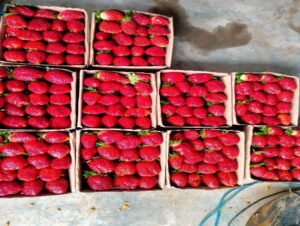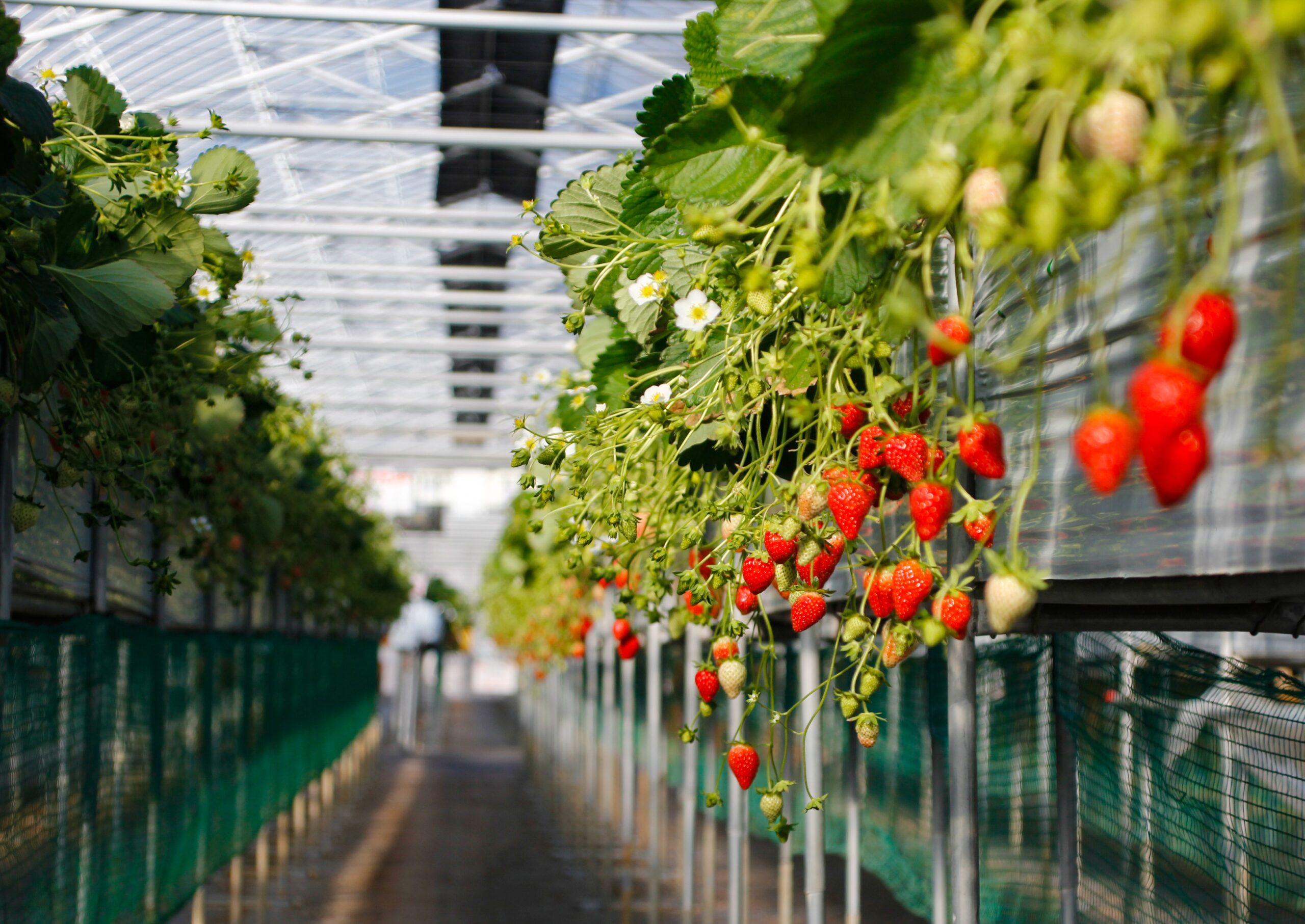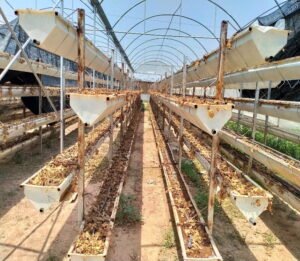Greenhouse Strawberry Production
Introduction
Greenhouse strawberry production is common now a days. Strawberry (Fragaria ananassa) have a place with Rosaceae family. This plant that is developed around the world; is popular for its sweet natural products that have a trademark fragrance, succulent surface, and appealing red tone. Individuals all around the world devour strawberries in huge amounts all things considered as new natural products or in handled food sources, for example, natural product juice, frozen yogurt, cakes, milkshakes or chocolates. Here discuss greenhouse strawberry production.
Presently 80% of UK strawberry creation for general stores becomes under polythene burrows. Secured development has made conceivable the extension of the collect season, especially in the prior period, permitting an increment in the utilization of homegrown strawberries in rivalry with imports from the Mediterranean regions.
World top developing nations are America, Turkey, Spain, Egypt and South Korea. In Pakistan first time strawberry was filled in 1951. After preliminaries, two verities were suggested for development. These verities were Missionary and Klondike. Presently its development is expanding in Pakistan. In Punjab developing locales are Sheikhupura, Nankana, Gujranwala, Sialkot, Gujrat, Qasor, Mendibhawaldeen, Sargodha, Rawalpindi, Jhelum also, Chakwal. In KPK, strawberry is developed in Smack, Abtabad, Manshera, Maripur, Mardan Charsada and Peshawar. Strawberry can be delivered in any season by ensured conditions. We can create agreeing to its interest on the lookout. A few sorts of assortments have been created in Pakistan based on the climate.
Strawberry cultivating is for the most part done in the slope region in Pakistan. However, through secured development, it very well may be developed in any area. Nurseries are basically utilized in ensured development. Under which dampness and composts are given on schedule. The rancher can get more pay by creating strawberries at a lower cost. Here are the complete details of greenhouse strawberry production.
Overview of greenhouse strawberry production.
Importance
Strawberries mainly consist of water (91%) and carbohydrates (7.7%). They contain only minor amounts of fat (0.3%) and protein (0.7%).
The nutrients in 3.5 ounces (100 grams) of raw strawberries are:
Calories: 32
Water: 91%
Protein: 0.7 grams
Carbs: 7.7 grams
Sugar: 4.9 grams
Fiber: 2 grams
Fat: 0.3 grams
Planting
Commonly, strawberries are proliferated from sprinter plants developed by enormous business cultivators. The offer of sprinter plants is as often as possible a sideline business which supplements the fundamental pay from the organic product. The best strawberry transfers are not exactly a year old. A decent transfer ought to have a broad sinewy root framework, seven or eight crawls long. This kind of root framework ordinarily grows best in rather free sandy soil. Such soil too works with burrowing the plants and cleaning the roots for bundling.
Time and spacing
We should complete our plantation on 15th of September 2020. It is an ideal time for planting as it ensures good development for increased productivity the following season. Fall planting is not recommended due to greater problems with weed control and other problems.
- Plant to plant distance = 4 inches
- No. of plants in a row = 300
- No. of rows in a tray = 2
- Total no. of plants in a tray = 600
- No. of planted trays = 75
- Total plant population = 600*75 => 45000

Specifications of planting poles of strawberries.
- Distance between two poles = 4ft
- Total Distance between two trays = 2ft
- Distance of first tray above ground = 1ft
- No. of trays per pole = 4
- Length of a pole = 7ft
- Length of a tray = 100ft
Climatic requirements
Strawberries need to bloom and come to reap in cool to warm climate. The ideal temperature for strawberry developing is 60°F to 80°F; those temperatures permit strawberries to foster solid roots and take up supplements important to deliver bunches of roses and organic product. Powerless plants won’t deliver a solid gather and ordinarily won’t endure summer heat–maintained temperatures of 85°F or more noteworthy.
To accomplish greatest yield, great natural product size and organic product set a general moistness of 65 to 75 % was thought about ideal for summer creation of strawberries. Outrageous high dampness had negative impacts on natural product immovability and timeframe of realistic usability. Organic products turned out to be more vulnerable to natural product decay disease.
Media that can be used
Peat moss
Coco-coir
Perlite
Irrigation
We inundate strawberries through dripline. Keep the leaves as dry as could be expected, as strawberries are helpless to spoil in soaked conditions. We have introduced HEIS for this. It is the most productive innovation that utilizes water, manures, and supplements. Its primary standard is to apply water and different information sources gradually, routinely, and often as close to the plant roots as conceivable through producers introduced on plastic lines spread out in the plate.
Standard and opportune accessibility of supplements all through the plant development period according to correct necessities and upkeep of good soil dampness conditions work with to augment crop efficiency. Dribble water system innovation is most appropriate for high worth harvests. It has turned into the most esteemed development, which improves utilization of water and composts by upgrading the water system productivity as much as 95%.
Benefits of R.O. water
- Harmful dissolved contaminants reduced
- Sodium reduced
- Bad tastes and odors reduced
- More environmentally friendly than other water systems
- Easy to install and maintain
- Reduce TDS.
Thermometer and hygrometer installation
Temperature is first factor we need to monitor, but humidity is a close second. It’s important to know the amount of water vapor in the air as some plants will need a more or less humid environment to grow optimally. We have to measure tempt. And R.H. in the greenhouse to grow strawberries.
Read Also: Top 5 healthy fruits
https://mianfarms.com/top-5-healthy-fruits/
Measuring of pH and TDS
You should measure the TDS and pH of water that you provided to the strawberries for their best growth. The ideal pH for strawberries is between 5.4 and 6.5. Total dissolved salts (TDS) for strawberries should be <450 mg / L.
How to measure pH of water?
- Calibrate the pH meter.
- Uncap the instrument.
- Dip in the solution.
- Press enter
- Note the readings.
- Repeat the process 3 times.
How to measure TDS?
- Open the instrument.
- Take solution and dip the TDS meter.
- Note readings.
Harvesting and packaging
Organic product(fruit) is ordinarily prepared for gathering 4 a month and a half subsequent to blooming. We collect just completely red (ready) berries, and pick like clockwork. We cut by the stem; however, don’t pull the berry it might harm the plant. The most ideal way of collecting strawberries is to get a handle on the stem between our pointer and thumbnail, then, at that point, gently pull and curve simultaneously. Allow the berry to move into the palm of our hand. Delicately place the natural product in a container.
Strawberries are bundled in boxes or plate with a greatest substance of 5 kg net, in units of direct deal and masterminded in a solitary layer. The bundles should be new. The harmed strawberries should be figured out. So, greenhouse strawberry production is done by applying these above procedures. It is the complete greenhouse strawberry producton.


[…] https://mianfarms.com/greenhouse-strawberry-production/ […]
[…] the strawberries are fully ripe and red, remove them from the plant vines. With your fingertips, gently pull the […]